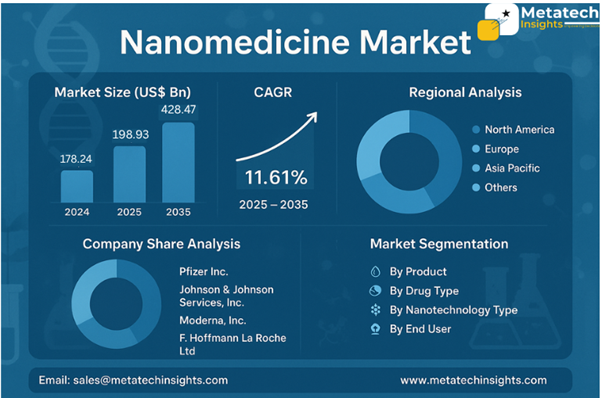Global Nanomedicine Market to Hit USD 428.47 Bn by 2035 | CAGR 11.61%
28 Jul 2025 | Report ID: MI3225 | Industry: Healthcare | Pages: 220 | Forecast Year: 2025-2035

Read more about this report- Global Nanomedicine Market to Hit USD 428.47 Bn by 2035 | CAGR 11.61%
- The Nanomedicine Market is valued at USD 178.24 billion in 2024.
- The Nanomedicine Market will achieve USD 428.47 billion by 2035 through a projected 11.61% CAGR from 2025 to 2035.
- The nanomedicine market is mainly affected by the rising number of people with chronic diseases, including cancer, cardiovascular diseases, neurological disorders, and infectious diseases, and the demand for individualized medicine. Second, the capability of nanotechnology to provide targeted effects of the therapeutics with few side effects is increasing the adoption. Nanotechnology has been applied to health care with eminent velocity due to a worldwide emphasis on the enhancement of drugs by bioavailability, the suppression of systemic dosing of toxicity, and the diagnostic precision of drugs, etc.
- Based on product, the historical market can be segmented into therapeutics, diagnostics, drug delivery systems, regenerative medicine, and vaccines. Nanotherapeutics have the largest share since they are increasingly being adopted in oncology, whereas nanodiagnostics is gaining ground as there is more demand to detect diseases early through nanoparticle-enhanced imaging agents and biosensors.
- The market has been segmented into drug types as small-molecule nanodrugs, biologic nanodrugs, and RNA nanodrugs. Nanodrugs based on RNA, especially the ones implemented in the mRNA vaccination technology, have seen explosive growth since they are applied to fight COVID-19 and have the potential to be implemented in the treatment of multiple genetic and infectious diseases.
- The market can be divided into nanoparticles, liposomes, dendrimers, nanorobots, quantum dots, and nanoshells by type of nanotechnology. The top two players in this segment are nanoparticles and liposomes because they have a wide application in medicine in the delivery of drugs and in treating cancer. The dendrimers and nanoshells have potential as targeted therapeutics and diagnostics, and clinical trials are underway.
- The market is segmented on an end-user basis into hospitals, specialty clinics, research institutions, and pharmaceutical firms. The major end users are hospitals and pharmaceutical firms due to the emerging trend in the use of nanomedicines in regular health practice and the persistence in the development and commercialization of nanodrugs. The research establishments are equally engaged in the very important role of developing the kinds of innovation in nanocarrier structures and applications.
- The principal forces that are propelling the market are perpetual affordability of nanomaterials, growth in amounts of research and development by states and non-state actors, and regulatory structures that support the regulatory procedures of nanodrugs. The market is also enjoying some more public-private ventures and schemes aimed at nanomedicine infrastructure. Future product development is being defined by clean-label nanomedicine platforms, biocompatibility, and scalability.
- The geographical segmentation applies to the market as North America, Europe, Asia Pacific, Latin America, the Middle East, and Africa. North America represents the greatest portion of the market because, in this region, there is a well-developed healthcare system, advanced technologies are widely used, and massive investments into nanomedicine are being made. The fastest-growing region is Asia Pacific, where R&D investment is increasing, the burden of diseases is growing, government attention is positive, and local pharmaceutical firms are assuming more responsibility.
- The important market participants of nanomedicine are Pfizer Inc., Johnson & Johnson Services, Inc., Moderna, Inc., F. Hoffmann-La Roche Ltd., and several others. These are highly involved in research and development, collaboration, and products in relation to nanodrug delivery, cancer therapy, RNA technology, and refined diagnostic tools. They are also targeting a broadening of regulatory and clinical validation and scaling out of nanomedicine solutions onto a broader therapeutic platform.
Maximize your value and knowledge with our 5 Reports-in-1 Bundle - over 40% off!
Our analysts are ready to help you immediately.
